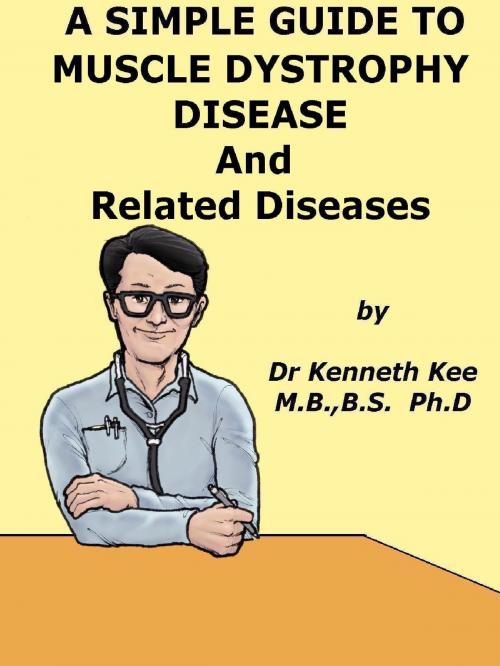A Simple Guide to Muscle Dystrophy Disease and Related Conditions
Nonfiction, Health & Well Being, Health, Ailments & Diseases, Musculoskeletal, Medical, Specialties, Orthopedics| Author: | Kenneth Kee | ISBN: | 9781301206612 |
| Publisher: | Kenneth Kee | Publication: | October 15, 2013 |
| Imprint: | Smashwords Edition | Language: | English |
| Author: | Kenneth Kee |
| ISBN: | 9781301206612 |
| Publisher: | Kenneth Kee |
| Publication: | October 15, 2013 |
| Imprint: | Smashwords Edition |
| Language: | English |
Muscle Dystrophy Disease
What is Muscle Dystrophy Disease?
Muscular dystrophy (MD) disease is a group of more than 30 inherited diseases that cause muscle weakness and muscle loss.
Some Muscular dystrophy disease can occur in infancy or childhood
Other Muscular dystrophy diseases do not appear until 40 years of age or later.
There is a difference in the various muscular dystrophies diseases in the people they affect and the symptoms of the disease.
All forms of Muscular dystrophy will become worse as the person's muscles become weaker.
Most people with Muscular dystrophy eventually lose the ability to walk.
There is no cure for muscular dystrophy.
What are the causes of muscular dystrophy?
Muscular dystrophy (MD) is a genetic disease that gradually weakens the body's muscles.
It is caused by incorrect or missing genetic information that prevents the body from making the proteins needed to build and maintain healthy muscles.
Duchenne muscular dystrophy is a sex-linked genetic disease where a boy born to a mother who is a carrier has a 50 per cent chance of having the disorder while his sisters will have a 50 per cent chance of becoming a carrier.
A child who is diagnosed with MD gradually loses the ability to do things like walk, sit upright, breathe easily, and move the arms and hands.
This increasing weakness can lead to other health problems.
There are several major forms of muscular dystrophy, which can affect the muscles to varying degrees.
In some cases, MD starts causing muscle problems in infancy; in others, symptoms don't appear until adulthood.
There is no cure for MD, but researchers are quickly learning more about how to prevent and treat it.
Doctors are also working on improving muscle and joint function and slowing muscle deterioration so that those with MD can live as actively and independently as possible.
What are the symptoms of Muscular dystrophy?
First Symptoms
Many children with muscular dystrophy follow a normal pattern of development during their first few years of life.
But in time common symptoms begin to appear.
A child who has MD may start to
-
stumble,
-
walk late and waddle,
-
have difficulty going up stairs, and
-
toe walk (walk on the toes without the heels hitting the floor).
-
A child may start to struggle to get up from a sitting position
-
have a hard time pushing things, like a wagon or a tricycle.
Children with MD often develop enlarged calf muscles (called calf pseudo hypertrophy) as muscle tissue is destroyed and replaced by fat.
How is Muscle Dystrophy diagnosed?
Diagnosis
-
family history, and ask about any problems particularly those affecting the muscles that the child might be having.
-
tests to determine what type of MD is involved and to rule out other diseases that could cause the problem.
-
a blood test to measure levels of serum creatine kinase, an enzyme that's released into the bloodstream when muscle fibers are deteriorating.
Elevated levels indicate that something is causing muscle damage. -
check the DNA for gene abnormalities or a muscle biopsy to look for patterns of deterioration
-
abnormal levels of dystrophin, a protein that helps muscle cells keep their shape and length.
What are the Types of Muscular Dystrophy?
The different types of muscular dystrophy affect different sets of muscles and result in different degrees of muscle weakness.
TABLE OF CONTENT
Chapter 1
Muscle Dystrophy Disease
Chapter 2
Fibromyalgia
Chapter 3
Myasthenia Gravis
Chapter 4
Multiple Sclerosis
Epilogue
Muscle Dystrophy Disease
What is Muscle Dystrophy Disease?
Muscular dystrophy (MD) disease is a group of more than 30 inherited diseases that cause muscle weakness and muscle loss.
Some Muscular dystrophy disease can occur in infancy or childhood
Other Muscular dystrophy diseases do not appear until 40 years of age or later.
There is a difference in the various muscular dystrophies diseases in the people they affect and the symptoms of the disease.
All forms of Muscular dystrophy will become worse as the person's muscles become weaker.
Most people with Muscular dystrophy eventually lose the ability to walk.
There is no cure for muscular dystrophy.
What are the causes of muscular dystrophy?
Muscular dystrophy (MD) is a genetic disease that gradually weakens the body's muscles.
It is caused by incorrect or missing genetic information that prevents the body from making the proteins needed to build and maintain healthy muscles.
Duchenne muscular dystrophy is a sex-linked genetic disease where a boy born to a mother who is a carrier has a 50 per cent chance of having the disorder while his sisters will have a 50 per cent chance of becoming a carrier.
A child who is diagnosed with MD gradually loses the ability to do things like walk, sit upright, breathe easily, and move the arms and hands.
This increasing weakness can lead to other health problems.
There are several major forms of muscular dystrophy, which can affect the muscles to varying degrees.
In some cases, MD starts causing muscle problems in infancy; in others, symptoms don't appear until adulthood.
There is no cure for MD, but researchers are quickly learning more about how to prevent and treat it.
Doctors are also working on improving muscle and joint function and slowing muscle deterioration so that those with MD can live as actively and independently as possible.
What are the symptoms of Muscular dystrophy?
First Symptoms
Many children with muscular dystrophy follow a normal pattern of development during their first few years of life.
But in time common symptoms begin to appear.
A child who has MD may start to
-
stumble,
-
walk late and waddle,
-
have difficulty going up stairs, and
-
toe walk (walk on the toes without the heels hitting the floor).
-
A child may start to struggle to get up from a sitting position
-
have a hard time pushing things, like a wagon or a tricycle.
Children with MD often develop enlarged calf muscles (called calf pseudo hypertrophy) as muscle tissue is destroyed and replaced by fat.
How is Muscle Dystrophy diagnosed?
Diagnosis
-
family history, and ask about any problems particularly those affecting the muscles that the child might be having.
-
tests to determine what type of MD is involved and to rule out other diseases that could cause the problem.
-
a blood test to measure levels of serum creatine kinase, an enzyme that's released into the bloodstream when muscle fibers are deteriorating.
Elevated levels indicate that something is causing muscle damage. -
check the DNA for gene abnormalities or a muscle biopsy to look for patterns of deterioration
-
abnormal levels of dystrophin, a protein that helps muscle cells keep their shape and length.
What are the Types of Muscular Dystrophy?
The different types of muscular dystrophy affect different sets of muscles and result in different degrees of muscle weakness.
TABLE OF CONTENT
Chapter 1
Muscle Dystrophy Disease
Chapter 2
Fibromyalgia
Chapter 3
Myasthenia Gravis
Chapter 4
Multiple Sclerosis
Epilogue















